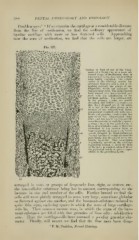Page 578 - My FlipBook
P. 578
;
588 DENTAL EMBRYOLOGY AND HISTOLOGY.
Prudden says : ' "If we exaniint- the cartilage at a considerable distance
from the line of ossification, we find the ordinary appearance of
hvaline cartilage with more or less flattened cells. Approaching
now the zone of ossification, we find that the cells are larger, are
Fig. 327.
Section of Part of one of the Limb-
bones of a Foetal Cat, at a more ad-
vanced Stage of Ossification than is
represented in Fig. ;?2!i, and somewhat
more higlily magnified. The calcifi-
cation of the cartilage matrix has
advanced from the centre, and is ex-
tending between the groups of car-
tilage-cells, which are arranged in
characteristic rows. The subperiosteal
bony deposit {im) has extended imri
passu with the calcification of the
cartilage matrix. The cartilage-cells
in the primary areote are mostly
slirunken and stellate; in some cases
they have dropped out of the space.
At //• and in two other places an ir-
ruption of the subperiosteal tissue,
composed of ramified cells with osteo-
blasts and growing bliKid-vessels, Inis
penetrated the subperiosteal bony
crust, and has begun to excavate the
secondary areolie or medullary spaces
;;, fibrous layer of the periosteum; o,
layer of osteoblasts : some of them are
embedded in the os.seous layer as
bone-corpuscles in lacuna;; bl, blood-
vessels occupied by blood-corpuscles,
rcyond the line of ossiflc advance the
periosteum may be noticed to be dis-
tinctly incurved. This incurvation
is gradually moved on, the cartilage
expanding behind it until the head
of the bone is reached, when it forms
the ])eriosleal notch (jr groove rejire-
sented in the preceding figure.
arranged in rows or gronps of frequently four, eight, or sixteen, etc.,
the intercellular substance being less in amount, corresjionding to the
increase in size and numl)er of the cells. Farther inward we find the
cells still more plainly arranged in rows, very large, sometimes globular
or fiattened against one another, and the basement-substance reduced to
quite thin septa, enclosing spaces in which the rows of large cartilage-
cells lie. Then comes a narrow zone, in which the septa of the base-
ment-substance are filled with fine granules of lime salts : calcification
zone. Here the cartilage-c-ells have assumed a peculiar granular cha-
racter. Finally, still nearer Me find that the lime salts have disap-
' T. M. Prudden, Normal Hisiolocjy.
588 DENTAL EMBRYOLOGY AND HISTOLOGY.
Prudden says : ' "If we exaniint- the cartilage at a considerable distance
from the line of ossification, we find the ordinary appearance of
hvaline cartilage with more or less flattened cells. Approaching
now the zone of ossification, we find that the cells are larger, are
Fig. 327.
Section of Part of one of the Limb-
bones of a Foetal Cat, at a more ad-
vanced Stage of Ossification than is
represented in Fig. ;?2!i, and somewhat
more higlily magnified. The calcifi-
cation of the cartilage matrix has
advanced from the centre, and is ex-
tending between the groups of car-
tilage-cells, which are arranged in
characteristic rows. The subperiosteal
bony deposit {im) has extended imri
passu with the calcification of the
cartilage matrix. The cartilage-cells
in the primary areote are mostly
slirunken and stellate; in some cases
they have dropped out of the space.
At //• and in two other places an ir-
ruption of the subperiosteal tissue,
composed of ramified cells with osteo-
blasts and growing bliKid-vessels, Inis
penetrated the subperiosteal bony
crust, and has begun to excavate the
secondary areolie or medullary spaces
;;, fibrous layer of the periosteum; o,
layer of osteoblasts : some of them are
embedded in the os.seous layer as
bone-corpuscles in lacuna;; bl, blood-
vessels occupied by blood-corpuscles,
rcyond the line of ossiflc advance the
periosteum may be noticed to be dis-
tinctly incurved. This incurvation
is gradually moved on, the cartilage
expanding behind it until the head
of the bone is reached, when it forms
the ])eriosleal notch (jr groove rejire-
sented in the preceding figure.
arranged in rows or gronps of frequently four, eight, or sixteen, etc.,
the intercellular substance being less in amount, corresjionding to the
increase in size and numl)er of the cells. Farther inward we find the
cells still more plainly arranged in rows, very large, sometimes globular
or fiattened against one another, and the basement-substance reduced to
quite thin septa, enclosing spaces in which the rows of large cartilage-
cells lie. Then comes a narrow zone, in which the septa of the base-
ment-substance are filled with fine granules of lime salts : calcification
zone. Here the cartilage-c-ells have assumed a peculiar granular cha-
racter. Finally, still nearer Me find that the lime salts have disap-
' T. M. Prudden, Normal Hisiolocjy.


